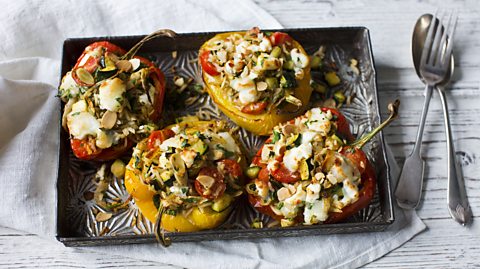What is a high-protein, low-GI diet?
When you eat, hormones are released from your gut to signal to your brain that you should stop eating. In the absence of a strong ‘stop eating’ signal you are likely to overeat. When following the high-protein, low-GI (glycaemic index) diet, you alter the types of food you eat in order to increase the gut hormone signal to your brain and trigger the ‘stop eating’ signal. This should help you to avoid eating too much at each meal.
The diet is also based on the principle that some foods are more filling than others. Choosing filling foods such as high-protein ingredients will help you to feel fuller for longer, so you will be less likely to snack between meals. There is no need to count calories on this diet.
The diet involves
- Increasing the proportion of protein in your diet. For weight maintenance about 20 percent of the energy value of your food should be from protein, for weight loss 25 percent.
- Choosing certain types of carbohydrate foods with a low glycaemic index
- Reducing the amount of fat and sugar in your diet
- Eating more fruit and vegetables

Principles of the diet
Foods with a low glycaemic index are digested more slowly. They are believed to boost the gut hormone response to food and therefore help you to avoid overeating at each meal. A low-GI diet can also help keep your blood-sugar levels more stable.
It can be difficult to know the GI of a food because it isn’t shown on the label. A low-GI food has a glycaemic index of less than 55. You can buy a book that lists the GI value of foods or look it up on the internet. You only need to look at the GI for carbohydrate-rich foods. Pasta (especially wholegrain varieties), lentils and basmati rice are low-GI carbohydrates.
In addition, we recommend you reduce the energy density of your diet and increase the amount of fibre. You can do this by eating less fat and sugar and a higher proportion of vegetables and fruit. This will help to reduce hunger between meals.
What you can eat daily
A variety of different kinds of protein including fish, poultry and eggs as well as red meat. Vegetable proteins such as beans and lentils are especially good, as they are low-GI as well as high-protein. You can add beans to stews to help lower the GI.
Aim to have three portions of fruit each day, either as a dessert or snack between meals if you are hungry. Do not add extra sugar to fruit. You can buy fruit fresh, frozen or canned in water or juice (not syrup). Avoid particularly high-GI fruits, such as watermelon and ripe bananas. You can eat fruit with natural yoghurt, but avoid ready-made ‘fruit’ yoghurts, which tend to contain little fruit and lots of added sugar.
Aim to have at least two servings of vegetables with each main meal. One serving is about the size of a handful. Vegetables should cover about half your plate at a main meal. They add bulk to your diet but usually very few calories, so you can use them to fill up your plate and your tummy. You can eat as many vegetables as you wish, except for those with a high GI, such as beetroot and pumpkin. Do not add any fat to vegetables; they should be boiled, steamed or microwaved. You can also have salads without added fat. For the purposes of this diet, potatoes do not count as a vegetable – they are a starchy food, high in calories and with a high GI, so should be avoided. If you must have potatoes choose waxy new salad potatoes. Ideally cook, cool, then reheat thoroughly before serving. Heating and cooling changes the starch structure and lowers the GI.
Foods to avoid
You need to minimise your consumption of foods that are high in fat or sugar. These foods are high in calories and will not help you to feel full. This means you must avoid:
- Sugar-sweetened drinks (diet versions are allowed)
- Confectionery
- Chocolate
- Ice cream
- Biscuits
- Cakes
- Pastries
- Crisps or other savoury snacks
- Jam, marmalade or other preserves
How can you follow the diet when eating out?
It’s hard to know the GI of foods, so stick with the basic principles of the diet – no potatoes or ordinary bread. Choose low-GI carbs, select meats that have been roasted or grilled rather than fried and avoid creamy sauces.